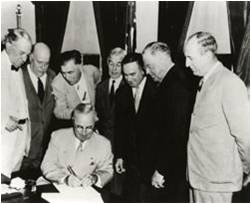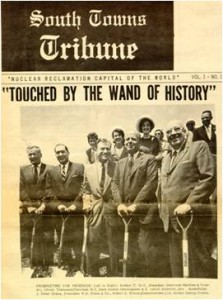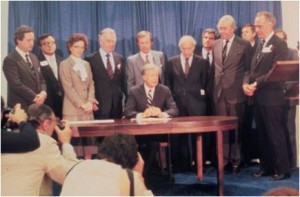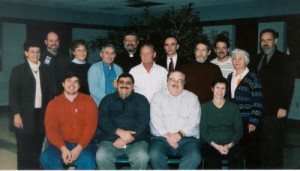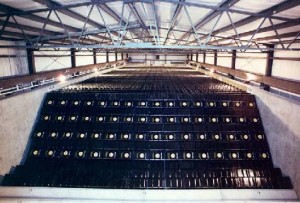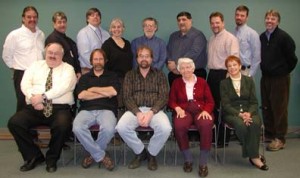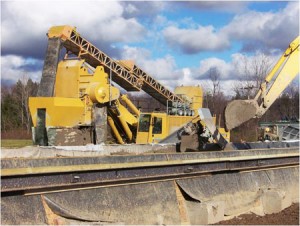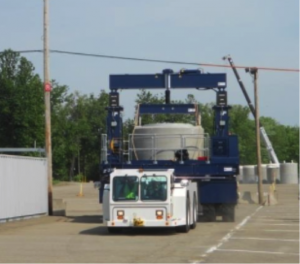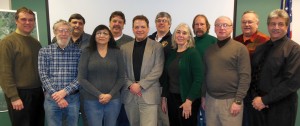Overview
Below is a brief narrative history of the Western New York Nuclear Service Center from its inception through the formation of the West Valley Demonstration Project and formation of the West Valley Citizen Task Force concluding with a summary of clean up work accomplished since 1980 and planned through Phase 1 Decommissioning.
Following narrative more detailed chronology by year providing information about significant events.
A Brief Narrative History
In 1954, the U.S. Atomic Energy Commission (AEC) began a program to encourage the private reprocessing of spent nuclear fuel as part of a program to commercialize the nuclear fuel cycle. New York State became interested in the AEC privatization program as a way to promote industrial development within the State. By 1961, New York State’s Office of Atomic Development acquired 3,300 acres in Cattaraugus County with the intent of establishing a spent fuel reprocessing facility.
The AEC announcement also created interest within the business community, and the Davison Chemical Company, W.R. Grace and Company and American Machine and Foundry (AMF) set up Nuclear Fuel Services Inc. (NFS) to pursue the spent fuel reprocessing venture. Negotiations among NFS, AEC, and New York State on the operation of the plant were completed in 1962, and construction began in 1963. The plant was completed in 1966 at a cost of about $33 million. NFS was licensed as the operator, and the New York State Atomic Research and Development Authority (a predecessor agency of the New York State Energy Research and Development Authority) was licensed as the owner.
NFS reprocessed 640 metric tons of spent fuel between 1966 and 1971. Sixty percent of this fuel was from the N-reactor at Hanford – supplied by AEC under a baseload contract with NFS. During the time it operated, the facility experienced operational difficulties, higher than expected worker doses, and unplanned releases of radioactive material to the environment. In addition to spent fuel reprocessing, NFS established two radioactive waste disposal areas at the Center – a commercial radioactive waste disposal facility, and a separate facility that was used for the disposal of high-activity reprocessing waste with radiation levels that were too high to be buried in the commercial disposal facility.
After operating the facility for six years, NFS halted reprocessing operations in 1972 in order to make modifications to the plant. NFS expected that these modifications would cost $15 million. During the shut-down period, new regulatory requirements were issued by the AEC related to earthquake and tornado protection and waste management. NFS estimated that meeting these new requirements could cost $600 million, and NFS informed New York that it was withdrawing from the reprocessing business and intended to turn the facility over to the State. At that time, the facility contained 750 spent fuel assemblies that had not been reprocessed, 600,000 gallons of liquid high-level radioactive waste (HLW) stored in steel tanks, the highly contaminated Main Plant Process Building, and two radioactive waste disposal areas that contained almost 3 million cubic feet of waste in unlined trenches.
New York State refused to take possession of the facility because the facilities did not meet the requirements for transfer to the State. Congress held hearings, directed the GAO to investigate the issues, and directed DOE to study options for the future of the Center. These activities eventually led to Congress passing the West Valley Demonstration Project Act in 1980.
In 1982, in accordance with the West Valley Demonstration Project Act, the U.S. Department of Energy (DOE) took control of about 200 acres of the site and began the process of solidifying the liquid HLW wastes, and in decontaminating and decommissioning the facilities used in the solidification project. The New York State Energy Research and Development Authority (NYSERDA) is responsible for management of the shut down commercial radioactive waste disposal site and the balance of the Center. NYSERDA, as the owner, is also the licensee for the site.
As part of the decision making process for site cleanup and decommissioning, DOE and NYSERDA jointly issued an Environmental Impact Statement (EIS) for completion of the project. In 1996 a draft EIS was released which contained no preferred alternative. Numerous comments were received and the agencies agreed to issue a revised draft with a preferred alternative. The West Valley Citizen Task Force (CTF) was formed in 1997 to provide broader public participation in the EIS and decontamination and decommissioning processes. The CTF issued a report in 1998 addressing what it felt should occur and has been meeting regularly since then. Members of the CTF are drawn from local government, community and environmental organizations, representatives of elected officials and the Seneca Nation of Indians.
A Draft EIS was released for public comment in November 2008. The Decommissioning Plan was also delivered to NRC in December 2008. A Final EIS, Record of Decision and New York Finding Statement were released in the spring of 2010. A phased decision making approach was selected. Phase 1 of decommissioning activities is underway. The core of that work will be the relocation of 275 HLW canisters to a new on-site interim storage system; demolition and removal of the Main Plant Process Building, Vitrification Facility, and the source of the North Plateau Groundwater Plume; removal of the low-level waste water treatment system, the four operating lagoons, and one closed lagoon; shipment and disposal of all of the project-generated low-level waste and transuranic waste; and removal of numerous ancillary facilities. In order to address some technical issues identified in the EIS, a Phase 1 Studies Process was developed by DOE and NYSERDA with subject matter experts engaged and an Independent Scientific Panel formed. The agencies plan to make a Phase 2 decision in 2020. There is presently no disposal facility for the high-level radioactive waste at West Valley, or for the West Valley transuranic waste.
Work Accomplished Since 1980 and Work Planned for Phase 1 Decommissioning – Facility Disposition
DOE, through its contractor CH2MHill B&W West Valley, LLC (CHBWV), is moving forward with the Phase 1 Decommissioning – Facility Disposition. This contract is for the relocation of the HLW canisters, demolition of the Main Plant Process Building and Vitrification Facility to ground-level, shipment and disposal of low-level waste, and removal of ancillary facilities.
Since 1980 major work accomplished at WVDP by DOE and its contractors includes:
- Vitrification of liquid high-level radioactive waste into glass. This glass is now encased in canisters and stored on-site in 275 ten-foot tall stainless steel canisters awaiting a long-term storage solution. At this time there is no operating national long-term storage facility receiving high-level radioactive waste.
- Removal of the equipment used in the vitrification process, and shipment of most of this waste for off-site disposal.
- Removal of 125 spent nuclear fuel assemblies from a storage pool and shipment to the Idaho National Laboratory for storage.
- Decontamination of a number of areas within the Main Process Plant Building. More than 100,000 cubic feet of low-level waste has been shipped for disposal.
- Infrastructure reduction through demolition of unnecessary building and facilities.
- Ongoing environmental monitoring and characterization of contaminated areas.
- Installation of a drying system for the High Level Waste Tanks and Vaults.
- Installation of a geomembrane cover on the NRC Licensed Disposal Area.
- Installation of Permeable Treatment Wall along leading edge of the North Plateau Groundwater Plume.
- Complete high level waste canister relocation to a newly constructed storage pad at WVDP.
- Process, ship and dispose of all legacy low-level waste off-site.
NYSERDA is responsible for the State-Licensed Disposal Area (SDA) a 15-acre portion of the site where solid radioactive wastes were buried. In the 1970s and 1980s, water infiltrated the burial trenches and, because of the clay soil, these trenches began to fill with water. NYSERDA installed a geomembrane covering the SDA to prevent additional infiltration as well as a subsurface barrier wall to prevent groundwater from moving into the trenches. The cover has reduced infiltration of precipitation and snow melt. NYSERDA actively manages and monitors the SDA.
Upcoming joint DOE/NYSERDA Activities:
- Prepare a Supplemental EIS for Phase 2 decisions.
- Arrive at a Phase 2 decision.
WVDP work to be conducted under the current contract:
- Demolition and removal of the Main Process Plant Building and the Vitrification Facility.
- Reduce infrastructure through demolition or removal of additional structures.
WVDP work to be conducted under the next contract as part of the Phase 1 clean up.
- Remove source area of North Plateau Groundwater Plume under Main Process Plant Building once it is demolished.
- Removal of the low-level wastewater treatment system.
Detailed Chronology
Historical highlights of the Western New York Nuclear Service Center, West Valley Demonstration Project and the West Valley Citizen Task Force.
Jump to:
1960’s 1970’s 1980’s 1990’s 2000’s 2010’s 2020’s
1954:
- Atomic Energy Act is enacted. The Act promotes civilian nuclear power and commercialization of the fuel cycle policy.
1959:
- New York State establishes the Office of Atomic Development as an independent agency to coordinate atomic regulatory and development functions.
1961:
- New York State Office of Atomic Development obtains 3,345 acres near West Valley through eminent domain – referred to as the Western New York Nuclear Service Center (WNYNSC) or the Center.
1962:
- Davison Chemical establishes Nuclear Fuel Services (NFS) to reprocess nuclear fuel at the WNYNSC.
- New York is designated an “Agreement State” by the Nuclear Regulatory Commission (NRC).
- New York Legislature creates the New York Atomic Energy Research and Development Authority (NYARDA).
1963:
- The Atomic Energy Commission (AEC) issues a construction permit to NYARDA and NFS to construct a nuclear fuel reprocessing plant on 200 acres of the WNYNSC site.
- Over the next several years the plant is constructed with the capacity to process 300 metric tons annually. NFS gains licenses to operate the facility from the NRC and New York State agencies.
Return to Top of Page
Go to start of Detailed Chronology
1966 through 1969:
- NFS begins processing operations in 1966 and through 1972 processes 640 metric tons of spent nuclear fuel. About three-fourths of this is provided by the Atomic Energy Commission, including spent fuel from U.S. defense reactors.
- During plant operations 660,000 gallons of highly radioactive liquid waste are generated and stored in underground tanks with a design life expectancy of 40 years.
- NFS uses 15 acres for in-ground disposal of waste from commercial waste generators and 7 acres for wastes generated through reprocessing.
- In 1968 a filter blowout releases cesium into the air which is carried to the northwest and deposited on the ground.
- AEC investigates leaks at the site.
Early 1970’s:
- In 1972 NFS suspends processing operations to to pursue plant modifications to double the reprocessing capacity, add several conversion facilities and a high-level waste solidification and storage unit, and make modifications to reduce occupational radiation exposure and reduce radioactive effluents. The AEC determines that these modifications require a re-licensing review. During the early 1970’s the environmental movement gains strength and significant federal and state legislation is enacted supporting stricter regulation.
- In response to reports of leaks and worker exposure the Coalition on West Valley Nuclear Wastes is formed. The group advocates for the closure and cleanup of the WNYNSC.
- By 1975 the SDA is infiltrated with water and overflows leading to leaks of radioactivity into nearby streams. Periodic pumping of the trenches begins.
- Pipes under the Main Process Plant Building leak strontium-90 and other liquid waste. This is discovered years later and is the source of what is now known as the North Plateau Ground Water Plume. (Aerial photo of plume area.)
Return to Top of Page
Go to start of Detailed Chronology
1976:
- NFS determines that costs and regulatory requirements of reprocessing make continued operations impractical. Under its lease with the the State of New York, NFS exercises its right to leave the site as of December 31, 1980.
- The state enters discussions with the Federal Energy Research and Development Administration to sort out ownership of the waste and environmental remediation responsibility.
- This is a unique situation in that the WNYNSC is the only commercially-operated fuel reprocessing facility in the nation; all others are operated by DOE.
1978:
- DOE issues “Western New York Nuclear Service Center Study” on the facility.
- Plutonium is found in sediment above the Springville Dam.
Return to Top of Page
1980:
- Congress passes the West Valley Demonstration Project Act which directs DOE to take the lead in addressing issues at the site. (NFS formally transfers possession of the site and reprocessing facilities in 1982 to DOE. Responsibilities under the NRC license are transferred to the state; however, the licenses are essentially suspended under federal legislation.)
- WVDP Act Signing
- The Act creates the West Valley Demonstration Project (WVDP) and requires the Secretary of Energy to enter into an agreement with New York State to carry out the project. New York is to pay 10% of the project costs and the federal government 90%.
- New York State and DOE enter a cooperative agreement. DOE is responsible for the cleanup and decommissioning of the reprocessing facilities and the NRC-Licensed Disposal Area (NDA). New York is responsible for the commercial low-level waste disposal area (SDA). While DOE has major responsibility, New York State, through NYSERDA, regularly consults on plans and progress.
1982 – 1992:
- In 1982 DOE selects West Valley Nuclear Services (WVNS), a Westinghouse subsidiary, to manage the cleanup and operate the site. DOE assumes control of 200 acres.
- In 1983 DOE selects vitrification, the incorporation of high-level waste into glass,as the preferred method for solidifying the approximately 600,000 gallons of liquid high-level waste at the site. The design and the testing of the process begins. NYSERDA assumes control of the State-Licensed Disposal Area (SDA) and focuses on minimizing water infiltration through active maintenance including the later installation of a geomembrane cover.
- In 1984 the first non-radioactive glass is poured in a test canister and testing continues for 5 years.
- In 1986 the decision to dispose of low-level waste at WVDP is contested in court by the Coalition on West Valley Nuclear Waste and is settled in 1987 by a Stipulation of Compromise. The settlement includes language stating that the EIS will include the effects of erosion at the site in the consideration of storage of low-level waste.
- In 1988 WVNS begins to pre-treat high-level waste with salt solutions to remove the lower-level waste and reduce the amount of glass that will be produced. Pre-treatment continues through 1995. Over 20,000 drums of waste are generated from pre-treatment.
- In 1989 DOE and NYSERDA begin development of the draft Environmental Impact Statement.
Return to Top of Page
Go to start of Detailed Chronology
1990 – 1996:
- 1990 DOE and NYSERDA enter into an agreement to prepare a joint EIS for the WVDP completion and closure of the WNYNSC.
- 1993 Contaminated groundwater surfaces in ditches on the north plateau. Over the next few years geoprobe investigations reveal a strontium-90 leak from process lines under the Main Process Plant Building occurred years earlier. In the ensuing years a pump and treat system is installed on the plateau.
- 1996 Vitrification of the radioactive high-level waste begins and continues through 2002. The glass is hardened into 10′ tall stainless steel canisters that are currently stored on site awaiting the opening of a federal repository for high-level radioactive waste.
- 1996 The draft EIS is released for public comment and receives 113 comment letters. No preferred alternative is identified in the draft EIS. This draft is revised and eventually released for public comment in late 2008.
1997 – 1999:
- The West Valley Citizen Task Force, an 18 member advisory group, is formed and holds its first meeting in late January 1997. In July 1998, the Task Force submits its Recommendations Report, to NYSERDA and DOE, on policies, priorities, and guidelines for the clean up, closure, or long-term management of the Center. Since 1998, the Task Force has met regularly to discuss a variety of issues regarding facility closure and long-term management of the Center.
- The mission of the Task Force has expanded into other areas including future site use, long-term stewardship, and regulatory issues. The group has provided several sets of comments to the U.S. Nuclear Regulatory Commission on its policy statement on the decontamination and decommissioning criteria for West Valley. The Task Force is also active in keeping the Congressional Representatives from the Western New York Region informed about the ongoing issues at the West Valley Site.
- in 1999 and 2000 DOE issues Records of Decision on the Final Waste Management Programmatic Environmental Impact Statement for Managing Treatment, Storage, and Disposal of Radioactive and Hazardous Waste.
- West Valley Citizen Task Force – Approximately 1998
Return to Top of Page
Go to start of Detailed Chronology
2000 – 2004:
- 2000 construction begins of Remote-Handled Waste Facility designed to disassemble the large-scale highly contaminated equipment from the vitrification process.
- 2001 DOE and NYSERDA issue Notice of Intent to complete the Cleanup and Closure EIS (1996) and prepare a separate EIS on decontamination of WVDP facilities.
- 2001 spent nuclear fuel assemblies are removed from storage pools and prepared for shipment.
- 2002 vitrification is completed and 275 canisters are stored on-site awaiting a final disposal location.
- 2002 NRC issues a Final Policy Statement for decommissioning criteria for the WVDP prescribing the License Termination Rule (LTR) as the applicable criteria. The Policy Statement also provides for certain flexibility to consider other alternatives to the LTR if it is demonstrated that the LTR cannot be met. The CTF corresponds with NRC expressing its concerns with the Policy Statement.
- 2003, 125 spent fuel assemblies are shipped off-site to the Idaho National Engineering Laboratory and the fuel pool area where they were handled is decontaminated.
- 2003 DOE and NYSERDA issue Notice of Intent to prepare an EIS for Decommissioning and/or Long-Term Stewardship.
- 2004, more than 100,000 cubic feet of low-level waste is shipped off-site for disposal. Demolition of buildings and facilities that will not be needed occurs in order to reduce ongoing costs.
Return to Top of Page
Go to start of Detailed Chronology
2005:
- The Final Waste Management Environmental Impact Statement for West Valley is approved.
- Low-level waste shipments continue at an increased pace.
- The Internal Draft EIS for Decommissioning and/or Long-Term Stewardship is provided to cooperating agencies for review.
2006:
- A “Core Team” is formed consisting of DOE, NYSERDA, NRC, EPA, NYSDEC and NYSDOH. The Internal Draft EIS generates more than 1700 comments prompting the agencies to attempt to resolve technical issues prior to release of the draft EIS to the public.
- The State of New York sues the Department of Energy alleging harm to the natural environment and seeking to clarify responsibility for certain aspects of the cleanup, an issue that has delayed action.
2007:
- DOE develops a plan to remediate the source area and contain the North Plateau Ground Water Plume.
- DOE presents to the CTF “The Way Ahead”a potential path forward under consideration by the Core Team.
- Last of more than 20,000 drums of low-level waste from the pre-treatment process are shipped to the Nevada Test Site for disposal.
2008:
- January, the Core Team presents its Recommended Preferred Alternative (PowerPoint Slideshow) to the CTF.
- Late 2008, DOE and NYSERDA release Draft Environmental Impact Statement for public comment. DOE publishes notice of availability of Decommissioning Plan.
- NYSERDA presents its Quantitative Risk Assessment for the State-Licensed Disposal Area.
- A group of four environmental organizations releases a Full Cost Accounting Study for the cleanup of WVDP.
- DOE installs a geomembrane cover on the NDA to prevent water infiltration.
- Return to Top of Page
2009:
- Citizen Task Force develops comments for DOE on Draft Environmental Impact Statement and for NRC on Decommissioning Plan.
- Work continues on Main Plant Process Building to prepare it for future demolition.
- High-level Waste Tank and Vault drying system design and preparation begins.
- North Plateau Groundwater Plume preliminary design of permeable treatment wall.
- Additional staff hired and work initiated under the American Resource and Recovery Act.
- New York State and federal government reach mediated settlement to most of issues in litigation. Consent Decree allocates respective financial responsibility for clean of known wastes and process for resolving responsibility for contamination found in the future. Public comment period begins.
- DOE submits Revision 2 of Phase 1 Decommissioning Plan for the West Valley Demonstration Project to NRC
Return to Top of Page
Go to start of Detailed Chronology
2010:
- Final EIS, Record of Decision and State Finding Statement released to Decommissioning and/or Long-Term Stewardship
- US District Court approves Consent Decree.
- Minor contamination event in Main Plant Process Building.
- Permeable Treatment Wall Installed to capture Strontium-90 in the North Plateau Groundwater Plume.
- High-level Waste Tank and Vault Drying System installed.
- Nitrocision process used to clean extraction cells.
- NYSERDA releases Focused Corrective Measures Study for the State-Licensed Disposal Area.
- NRC Transmits Technical Evaluation Report on Phase 1 Decommissioning Plan to DOE
- DOE and NYSERDA initiate Phase 1 Studies Process
2011:
- DOE and NYSERDA agree on “Guidance for Identifying and Conducting Potential Phase 1 Studies on the Decommissioning and/or Long-Term Stewardship of the West Valley Demonstration Project”
- Equipment dismantlement in the extraction cells, Main Plant Process Building decontamination and other work to prepare the building for demolition.
- Radioactive waste processing and shipping continued.
- DOE release Waste Incidental to Reprocessing Draft Evaluation for the WVDP Melter.
- CHBWV wins bid for seven year contract for Phase I Decommissioning and Facility Disposition activities. The contract is a performance-based, cost-plus-award-fee, completion type contract with cost and schedule incentives with a total value of $333.4 million.
2012:
- DOE releases Waste-Incidental-to-Reprocessing Evaluation for the West Valley Demonstration Project Vitrification Melter.
- LLW and Mixed LLW shipments continue as do preparations for decommissioning of the MPPB.
- Phase 1 Study Independent scientific Panel and Subject Matter Experts for the Erosion Working Group, Engineered Barriers Working Group and Exhumation Working Group are engaged and a Climate Change Workshop is hosted by DOE and NYSERDA. Climate experts issue guidance. Erosion Working Group releases draft Recommendations Report, CTF comments on report.
- CTF comments on WIR draft evaluation for Concentrator Feed Makeup Tanks/HoldTank.
Return to Top of Page
Go to start of Detailed Chronology
2013:
- Demolition of 01-14 Building, Waste Tank Farm Test Tower, Environmental Lab and other completed.
- Construction of HLW Storage Pad completed and fabrication of HLW casks begins.
- LLW and MLLW shipments are accelerated with supplemental funding.
- NYSERDA completes Frank’s Creek Erosion Mitigation Project.
- NYSERDA reports increased leachate elevations in SDA Trench 14.
- Phase 1 Studies Exhumation Working Group releases draft Recommended Studies.
2014:
- DOE and NYSERDA agree to an integrated approach for Phase 2 Decommissioning Decisions that includes a framework for analyzing the entire Center, addressing uncertainty in the Phase 2 analysis, decision for all facilities and commitment to preparing an Supplemental EIS.
- MPPB preparation for HLW canister move and building demolition continue. Equipment purchased for moving HLW storage casks.
- CTF comments on Recommendations for Phase 1 Exhumation Studies.
- Lake 1 Spillway and Lake 2 Dam are repaired after damage from a severe storm event.
- Aerial Radiation Survey is conducted over the WNYNSC and Cattaraugus Creek from Springville to Lake Erie.
2015:
- First HLW canisters placed in Vertical Storage Casks and moved to HLW storage Pad.
- Legacy and newly generated waste shipments continue as does facility disposition.
- July storm event necessitates repairs to Lake 1 spillway, HLW haul road, Parshall plume and Erdman Brook and Frank’s Creek erosion control structures.
2016
- Last of 278 canisters of HLW vitrified waste loaded into the 56 Vertical Storage Casks and moved to the Storage Pad. This was completed one year ahed of schedule.
- The vitrification components (Concentrator Feed Makeup Tank, Melter Feed Hold Tank and Melter) which had been determined to be Waste Incidental to Processing shipped via by truck and rail to Texas for disposal.
- Probabilistic Performance Assessment for the Phase 2 decision making begins.
2017
- SC&A started work on the Supplemental Environmental Impact Statement (SEIS) for Decommissioning and/or Long-Term Stewardship at the West Valley Demonstration Project and Western New York Nuclear Service Center.
- Vitrification Facility Demolition Phase 1 completed.
- Main Plant Process Building (MPPB) deactivation work continued.
- MPPB ventilation reconfigured to prepare for demolition.
- Neptune and Company contracted to perform for Probabilistic Performance Assessment
- Phase 1 Studies continued with several reports issued.
2018
- Legacy Waste disposition completed
- Vitrification Facility demolition completed
- MPPB ventilation stack removed
- Joint DOE/NYSERDA Public Scoping Process for Supplemental EIS completed
- Joint DOE/NYSERDA Phase 1 Studies concluded.
Return to Top of Page
Go to start of Detailed Chronology
2019
- Vitrification Facility demolition waste disposition completed
- Completion of removal of more than 56,000 pounds of asbestos containing material from MPPB
- Removal of additional ancillary and balance of site facilities including Manipulator Repair Shop, Contact-Size Reduction Facility, Laundry Facility and Utility Room Extension, Low-Level Wastewater Treatment O2 Pad, Liquid Pretreatment System, Waste Tank Farm Condensers and Shelter, and Chemical Process Cell-Waste Storage Area.
- New natural gas line and electrical feed line installed.
- West Valley Demonstration Project Reauthorization Act passed (Link)
- Completed the demolition of the Main Plant Office Building and Utility Room building
- Continued deactivation work in MPPB including below grade rooms and cells, deactivation in the Product Purification Cell-South using Nitrocision® technology
- Infrastructure improvements to rail line, paving of lots, modifications to Drum Cell started
- Work impacted by COVID
2021
- Restored rail shipment capabilities for the site
- Continued preparation for the Main Plant Process Building (MPPB) demolition by:
- Installing a new water collection and treatment system
- Repurposing an administrative trailer complex into a multipurpose building to support MPPB demolition activities
- Completed deactivation of the General Purpose Cell, General Purpose Cell Crane Room, General Purpose Cell Crane Room Extension, and General Operating Aisle making them ready for future demolition
